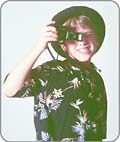A couple of months ago my sister called to ask me, the professional photographer in the family, about buying a new camera. The pivotal question: Should she buy a traditional 35mm camera or a cutting-edge digital one? Having no experience with digital cameras, I set out to do some research. I found that digital cameras on the market today enjoy higher resolution than ever before and range in price from $500 to $1,000—on a par, in other words, with standard 35mm SLR cameras. The number of digital brands now available is also equivalent to standard cameras, according to the Internet.
Browsing through downtown camera stores, I found Ken’s Camera (1327 Second, 223-5553) to be the most helpful. A sales clerk named Anthony patiently explained the basic principle behind digitals and showed me that they have all manner of features mimicking what you find on standard cameras: automatic programmed modes, manual controls, zoom lenses, etc. Instead of using film, they employ memory chips (there are four types now, each hoping to become the standard), the two leading kinds being Smartmedia and CompactFlash (the “Flash” referring not to a camera flash but to the type of memory storage). The $44.95 version of each holds 8 megabytes; the $189.95 version 132 MB.
Other brands of digital cameras range in price from $299.99 (for the Olympus D-340R, at 1.3 megapixels, with a fixed lens of 36mm equivalent) to such high-end models as the $899 Olympus C-2000Z (2.1 megapixels, zoom lens equivalent to 35-105mm) and the $949.99 Nikon Coolpix 950 (2.1 megapixels, 38-115mm zoom equivalent).
Sony makes the only digital camera that takes a floppy disk rather than a flash chip. The Sony FD-73 sells for $499.99, and the Sony Mavica FD-91, with a zoom lens equivalent to a 37-518mm on the 35mm camera, retails for $999.99. Depending on what level of resolution you choose and whether you choose to compress the images, you can store anywhere from two to 122 images on a single 8-MB chip.
The obvious advantage of chips over film, of course, is that chips are endlessly reusable. They are also easier to “develop”: You simply plug your camera into your computer and download the images, after which they can be stored on ZIP drives or burned into CDs for posterity.
The world of digital cameras is still chaotic, however. Not all cameras are compatible with all computers. Most are only compatible with Windows 95 or Windows 98, and those that are compatible with the Macintosh G3 require a special cable.
Most digital cameras have a screen installed, allowing immediate viewing of the image and instant deletion of poor pictures. This is not always an asset. Dirck Halstead, a Time photographer assigned to the White House, tells the story of the first time he saw video footage of Monica Lewinsky, who seemed vaguely familiar to him. He paid a researcher to go through his slides, and found his now-famous photo of Clinton hugging Lewinsky at a fund raiser. Why was Halstead the only one of the six photographers at the event with that picture? Because he was the only one not using a digital camera—the others had deleted their pictures of Clinton and the then-anonymous Lewinsky.
Print quality from digital cameras is still not up to the standards of traditional photography, so these cameras are best used as providers of images to the Web. For highest printed-image quality, you’ll need a color photo printer for your computer. One of the better ones is the Epson Stylus Photo 750 ($299.99; paper extra).
Still, technology is advancing rapidly, resolution quality is improving, prices are dropping, and new and improved models surface every six months or so. So while digital photography is best left to those with advanced computer skills, hefty budgets, and their own Web sites, it’s only a matter of time before less-skilled amateur photographers convert for good.
Alice Wheeler is a regular photographer for ‘Seattle Weekly.’






